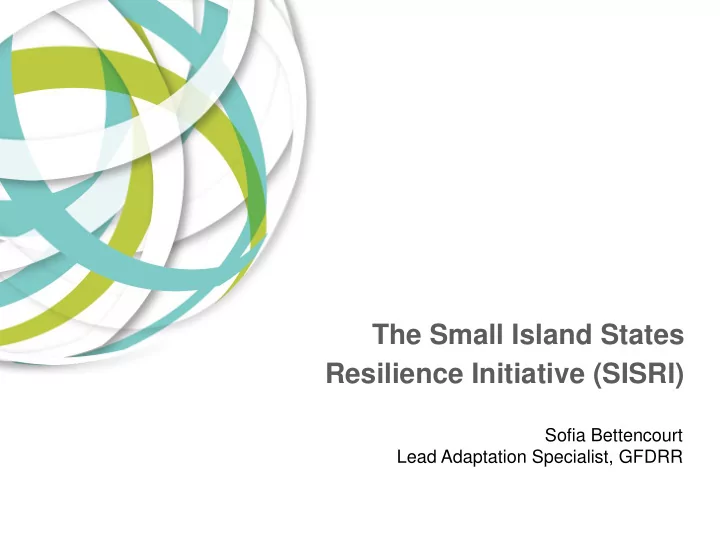

The Small Island States Resilience Initiative (SISRI) Sofia Bettencourt Lead Adaptation Specialist, GFDRR
The Small Island States Resilience Initiative (SISRI) • Resilience at the center • Current program and GFDRR’s role • Lessons learned • Scaling it up • Next steps
Resilience to Climate Change and Disasters is at the center of the development challenges faced by Small Island States • Small Island States account for two Average Annual thirds of the Disaster Losses countries with (as % of GDP) highest relative 10% 9% annual disaster 8% losses 7% 6% • 5% Losses average 4% 1-9% of GDP per 3% year 2% 1% 0% • This acts as a ‘leaking bucket’, pulling back economic growth and development Small Island States Other Countries
Four Regional Programs Emerging National-level investments; regional and national-level TA Pacific Islands Caribbean Program Program CCRIFI SPC/SOPAC IOC Indian West Ocean Africa Program (starting) (starting)
GFDRR has Provided Critically Important Support to this Growing Program ... • GFDRR Technical Assistance Grants Total Financing for Disaster and Climate Resilient Development in Small Island States Managed by the World Bank Group as a Trustee are active in 18 of the 26 countries (Active and Programmed Portfolio) US$1.5 billion where the WBG is supporting climate and disaster resilience $40.5 Million • In many cases, GFDRR funded the GFDRR initial TA that informed long-term Adaptation Fund programs PPCR Other TFs IDA • Financed by European Commission IBRD (ACP/EU), Government of Japan, MDTF, and Australia Source: World Bank Group Small Island States database • Main focus: 1. Mainstreaming 2. Risk Assessment 3. Risk Financing 4. Post Disaster Needs Assessments
Mainstreaming Resilience - the example of Belize • GFDRR Grant helped Belize prioritize transport infrastructure vulnerable to disasters • Government adopted a National Climate Resilience Investment Plan • US$430 million targeted for retrofitting and upgrading to disaster/climate change standards • This was followed by a US$30 million IBRD investment project, focusing on priority roads • Belize has now nearly closed the financing gap • The entire road network of Belize is expected to be made climate resilient
Risk Assessment - Measuring the Progress of Resilience • The Pacific Catastrophe Risk Assessment and Financing Initiative (PICRAFI), for example, has mapped more than 2 million buildings in areas at risk
Risk Financing – Expanding the Experience of CCRIFI to Current 16 members of CCRIF the Pacific and Indian Oceans The model of the Caribbean Catastrophe Insurance Facility (CCRIFI), is being replicated in the Pacific and Indian Ocean Island Regions with the support of GFDRR, the EC, Government of Japan and Regional Organizations. By pooling the risk across multiple countries, premiums can be lowered Anguilla Antigua and Barbuda The Bahamas Barbados Belize Bermuda Cayman Islands Dominica Grenada Haiti Jamaica Saint Kitts and Nevis Saint Lucia Saint Vincent and the Grenadines Trinidad and Tobago Turks and Caicos 8
Post Disaster Needs Assessments Current 16 members of CCRIF Preparing for Resilient Reconstruction • In recent years, GFDRR funded rapid post disaster assessments in St. Lucia, St. Vincent and Grenadines, Tonga, Solomon Islands, Seychelles and Comoros… • These assessments have facilitated countries’ access to funding for more resilient reconstruction… • Much of it was funded through grants What have we learnt? 9
Considerable available funding, but fragmented and not easily accessible • With few exceptions, no Small Island State has yet qualified for direct access to global climate funds • Access is through an accredited Implementing Agency – World Bank, ADB, UNDP, UNEP, FAO… • There are 9 different Implementing Agencies for the largest available fund, the Least Developed Green Countries Fund. Climate Fund • The Solomon Islands Funding through Multi-lateral Development Banks managed 22 different Dedicated Global Climate funds and/or funding through UN-agencies/programs CCA/DRM projects in 2012… Bilateral Funding Funding through Regional Organizations
Amount per Country not clearly linked to Vulnerability Some highly vulnerable Funding per Capita for Climate and Disaster Resilience, countries get relatively ( channeled through WBG as a Trustee) small allocations Funding influenced by: • IDA envelopes • UN’s Least Developed Country status • Maturity of national programs • Recent disasters • Donor traditional ties
There is a need to further combine funding and harmonize procedures to make financing more accessible and predictable Climate and Disaster Financing Roadmap: FRAGMENTED LANDSCAPE (Current Situation) NATIONAL PROGRAM APPROACH (Sources of funds are increasingly complementary) HARMONIZED PROCEDURES (Several Sources of funds following same procedures) DIRECT ACCESS (Funding combined, strengthened country procedures)
The Small Island States Resilience Initiative (SISRI) • Aims to facilitate and scale up the existing programmatic assistance • Specific to Small Island States • Combine Technical Assistance with investment • Focus on both disaster and climate risks • Allows for sharing of experiences across regions (Caribbean/Pacific/Indian Ocean/West Africa) • Would measure the progress of resilience within countries • Strengthen countries fiduciary and technical capacity to prepare them for direct access
Next Steps for SISRI • A dedicated thematic initiative specializing on Small Island States • Specialized Knowledge Products, such as: – Atoll Islands Resilience Study – SimpleCoast: On-line manual of simple coastal resilience options – Measuring Resilience in Small Island States – Best Practices in Climate and Disaster Risk Financing – Population Retreat from High Risk Areas – Project Management Best Practices • Facilitate access to financing – map out existing sources, aggregate funding, and identify gaps • Work with the WBG and other partners towards long-term, programmatic engagement
Questions? The Small Island States Resilience Initiative (SISRI) For further information, please contact: Sofia Bettencourt, sbettencourt@worldbank.org Francis Ghesquiere, fghesquiere@worldbank.org
Recommend
More recommend